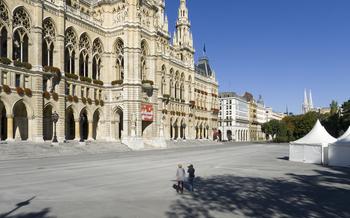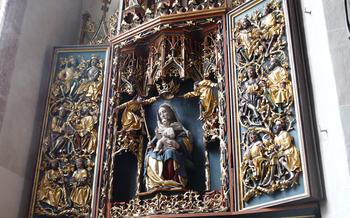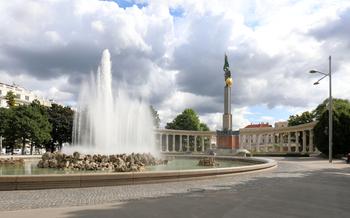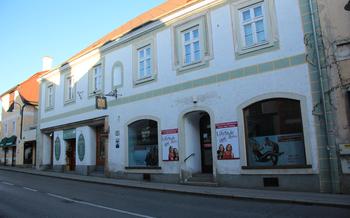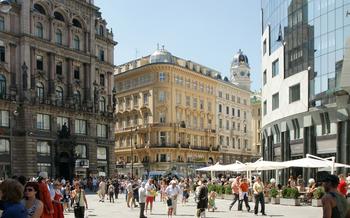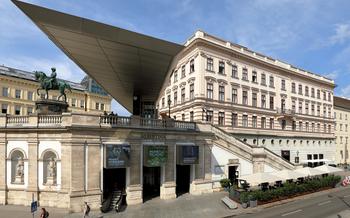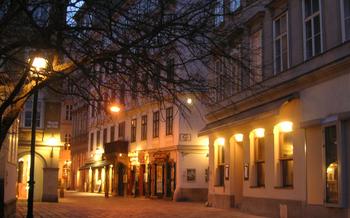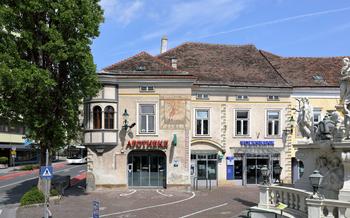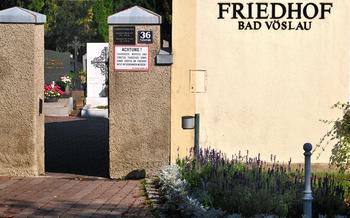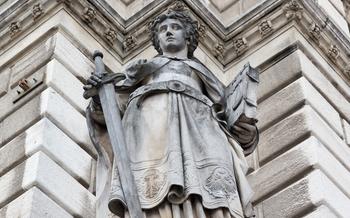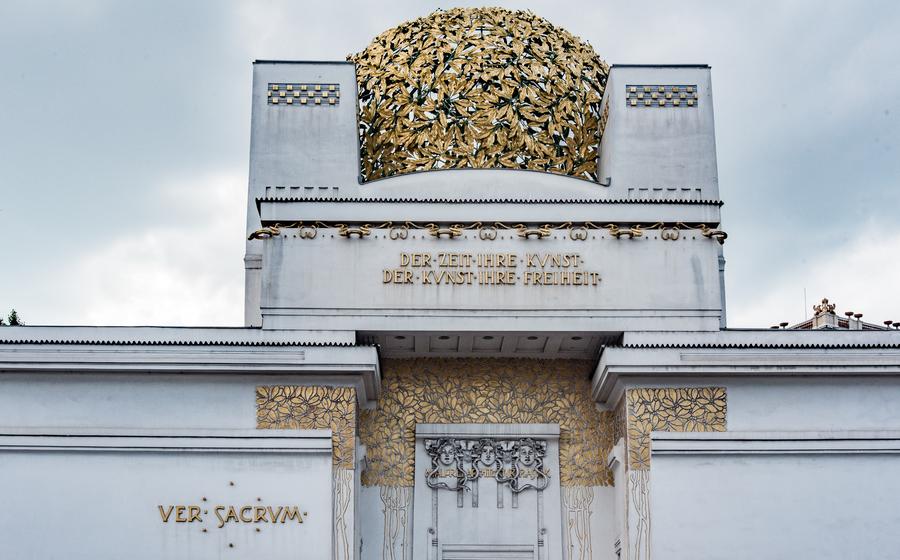
Secession Building
- Secession Building: A Monument to Art Nouveau in Vienna
- Historical Context: The Rise of Art Nouveau in Vienna
- Architectural Highlights: Exploring the Building's Exterior
- Interior Splendor: The Secession Exhibition Hall
- Gustav Klimt's Beethoven Frieze: A Masterpiece Unveiled
- Secession Shop: A Treasure Trove for Art Lovers
- Guided Tours: Unveiling the Building's Secrets
- Changing Exhibitions: A Platform for Contemporary Art
- Location and Getting There: A Secession in the City Center
- Photography and Social Media: Capturing the Secession's Essence
- Accessibility: Ensuring Inclusivity for All Visitors
- Nearby Attractions: Exploring Vienna's Cultural Treasures
- Café Secession: Indulge in Viennese Delights
- Insider Tip: Secession Card for Art Enthusiasts
Secession Building: A Monument to Art Nouveau in Vienna
The Secession Building stands as a testament to the transformative power of art and architecture. Erected in 1897, this iconic structure epitomizes the spirit of the Vienna Secession, a group of avant-garde artists who sought to break away from traditional artistic conventions. Designed by Josef Olbrich, a prominent architect and member of the Secession, the building is a masterpiece of Art Nouveau, characterized by its sinuous lines, intricate ornamentation, and bold use of color.
As a symbol of the movement's ideals, the Secession Building embodies a commitment to innovation, experimentation, and the celebration of artistic freedom. Its striking appearance and groundbreaking design continue to captivate visitors, making it a must-see destination for anyone interested in art, architecture, and cultural history.
Historical Context: The Rise of Art Nouveau in Vienna
The Secession Building stands as a testament to the vibrant art movement that flourished in Vienna at the turn of the 20th century. Known as the Vienna Secession, this movement sought to break away from the traditional, academic styles that dominated the art world at the time. Led by a group of forward-thinking artists, including Gustav Klimt, Otto Wagner, and Josef Olbrich, the Secessionists embraced a new aesthetic that celebrated individuality, creativity, and the rejection of conformity.
The Secession Building itself became a symbol of this movement, embodying its principles and serving as a platform for showcasing the works of its members. Designed by Olbrich, the building's innovative architecture and decorative elements reflected the Secessionists' commitment to breaking new ground and challenging artistic conventions. It quickly became a hub for artistic activity, hosting exhibitions, lectures, and performances that pushed the boundaries of art and design.
The Vienna Secession played a pivotal role in the development of modern art, not only in Austria but throughout Europe. It provided a space for experimentation and creative exchange, fostering the emergence of new artistic styles and techniques. The movement's influence can still be seen in the works of many 20th-century artists, including Egon Schiele, Oskar Kokoschka, and Friedensreich Hundertwasser, who continued to draw inspiration from the Secessionists' revolutionary spirit.
Architectural Highlights: Exploring the Building's Exterior
Josef Olbrich, a prominent architect and designer associated with the Vienna Secession, masterfully crafted the Secession Building. Its striking exterior is a testament to his innovative spirit and the principles of Art Nouveau.
The building's most distinctive feature is its golden dome, known as the "cabbage dome" due to its resemblance to a stylized cabbage head. This iconic dome, covered in shimmering gold tiles, creates a mesmerizing visual effect and has become synonymous with the Secession Building.
The facade of the building is adorned with intricate and symbolic ornamentation, reflecting the ideals of Art Nouveau. Secessionist artists embraced nature as a source of inspiration, and Olbrich incorporated floral and plant motifs into the building's design. The doorway, for example, is framed by a laurel wreath, symbolizing victory and achievement.
Overall, the Secession Building's exterior is a masterpiece of Art Nouveau architecture, showcasing Olbrich's innovative use of materials, forms, and symbolism. It stands as a testament to the artistic and cultural ferment that characterized Vienna at the turn of the 20th century.
Interior Splendor: The Secession Exhibition Hall
Step inside the Secession Building and be greeted by a breathtaking exhibition hall, a sanctuary for contemporary art. This spacious and well-lit space, designed by Josef Olbrich, provides the perfect backdrop for showcasing a diverse range of artistic expressions. The hall's flexible layout allows for dynamic and immersive exhibitions, catering to the ever-evolving landscape of modern art.
Over the years, the Secession Exhibition Hall has hosted a multitude of groundbreaking exhibitions, featuring works from renowned artists such as Egon Schiele, Oskar Kokoschka, and Gustav Klimt. Each exhibition brings a fresh perspective, challenging conventions and pushing the boundaries of artistic expression.
Beyond the temporary exhibitions, the Secession Exhibition Hall also boasts a permanent display of historical artifacts and documents, providing visitors with a glimpse into the history and significance of the Secession movement. Through these exhibits, visitors can delve deeper into the artistic and cultural context that shaped this revolutionary period.
Gustav Klimt's Beethoven Frieze: A Masterpiece Unveiled
One of the highlights of the Secession Building is Gustav Klimt's iconic Beethoven Frieze, a monumental artwork that adorns the building's exhibition hall. Created between 1901 and 1902, the frieze was commissioned by the Vienna Secession as a centerpiece for an exhibition dedicated to the composer Ludwig van Beethoven. Klimt's interpretation of Beethoven's Ninth Symphony resulted in a complex and multi-layered work of art that has become a symbol of the Secession movement and a masterpiece of Art Nouveau.
The frieze, which spans over 34 meters in length, is a visual representation of Beethoven's music, depicting various themes and emotions from the symphony. Klimt's use of gold leaf, vibrant colors, and intricate symbolism creates a mesmerizing and immersive experience for viewers. The frieze is divided into three main sections:
The long wall: Depicting the forces of darkness and evil, represented by mythical creatures and allegorical figures.
The central section: Featuring a majestic portrayal of Beethoven, surrounded by angels and muses, symbolizing the triumph of art and music over adversity.
The short wall: Showcasing a choir of angels singing in unison, representing the universal power of music to uplift and unite humanity.
Klimt's Beethoven Frieze is not only a stunning work of art but also a profound exploration of the human condition, reflecting themes of love, loss, and redemption. It remains one of the most beloved and celebrated artworks of the Secession period and a must-see for any visitor to the Secession Building.
Currently, the frieze is housed in a dedicated room within the Secession Building, ensuring its preservation and accessibility for visitors. The room is designed to provide optimal viewing conditions, allowing visitors to fully appreciate the intricate details and symbolism of Klimt's masterpiece.
Secession Shop: A Treasure Trove for Art Lovers
Within the Secession Building, visitors will find a treasure trove of unique souvenirs and gifts inspired by the building itself and its ever-changing exhibitions. The Secession Shop is a delightful space where art enthusiasts can indulge in a wide range of items that celebrate the rich history and artistic legacy of the Secession movement.
The shop offers a carefully curated selection of books, posters, and art prints featuring the iconic works of Gustav Klimt and other renowned Secessionist artists. These high-quality reproductions allow visitors to take home a piece of the Secession experience and continue to appreciate these masterpieces long after their visit.
In addition to these artistic treasures, the Secession Shop also offers a variety of unique souvenirs that pay homage to the building's architecture and design. From postcards and magnets featuring the Secession's distinctive dome to replicas of the famous Beethoven Frieze, there is something for every taste and budget.
By supporting the Secession Shop, visitors not only take home a cherished memento of their visit but also contribute to the ongoing mission of the Secession. The revenue generated from the shop helps to fund exhibitions, educational programs, and restoration projects, ensuring that this iconic building and its legacy continue to thrive for generations to come.
Guided Tours: Unveiling the Building's Secrets
Enhance your visit to the Secession Building by embarking on a guided tour, an enriching experience that delves into the intricacies of this architectural masterpiece. Led by knowledgeable guides, these tours provide a deeper understanding of the building's history, architecture, and artwork.
Expert guides bring to life the stories behind the Secession's construction, its role in the Vienna Secession movement, and the significance of Gustav Klimt's iconic Beethoven Frieze. They illuminate the symbolism embedded in the building's facade, revealing hidden meanings and allegories that may have otherwise gone unnoticed.
Different tour options are available to suit various interests and time constraints. Standard tours offer a comprehensive overview of the building's highlights, while specialized tours focus on specific aspects such as the architecture, the Secession movement, or Klimt's frieze. Private tours provide a personalized experience, allowing visitors to tailor the tour to their specific interests and curiosities.
Whether you are an art enthusiast, an architecture buff, or simply curious about Vienna's cultural heritage, a guided tour of the Secession Building is an unforgettable journey that will leave you with a profound appreciation for this architectural gem.
Changing Exhibitions: A Platform for Contemporary Art
The Secession Building is not only a historical landmark but also a dynamic platform for contemporary art. Throughout the year, the building hosts a series of changing exhibitions that showcase emerging and established artists from Austria and beyond. These exhibitions offer a glimpse into the latest trends and developments in contemporary art, providing visitors with a chance to engage with thought-provoking and innovative works.
The Secession's commitment to contemporary art dates back to its early days when it served as a meeting point for progressive artists who sought to break away from traditional conventions. Today, this tradition continues as the building hosts a diverse range of exhibitions that explore different artistic styles, mediums, and themes. From painting and sculpture to photography and installation art, the Secession provides a platform for artists to share their unique perspectives and challenge artistic boundaries.
One of the highlights of the Secession's exhibition program is the Secession Prize, which is awarded annually to an outstanding contemporary artist. The prize recognizes artistic excellence and innovation, and it has helped launch the careers of many prominent Austrian artists. Past winners of the Secession Prize include Maria Lassnig, Arnulf Rainer, and Erwin Wurm, whose works have gained international acclaim.
With its dynamic and diverse exhibition program, the Secession Building serves as a vibrant hub for contemporary art in Vienna. It offers visitors a unique opportunity to engage with cutting-edge artworks and experience the latest developments in the art world.
Location and Getting There: A Secession in the City Center
Nestled in the heart of Vienna's cultural district, the Secession Building stands as a beacon of artistic expression. Its prime location on Friedrichstraße, just a short walk from the Karlsplatz transportation hub, makes it easily accessible by public transportation. For those exploring the city on foot, the Secession's central position allows for a seamless integration into a leisurely stroll through Vienna's historic streets.
To reach the Secession Building by metro, take the U1 line and alight at the Karlsplatz station. From there, it's just a short walk along Friedrichstraße until you reach the building's distinctive gold-domed roof. Alternatively, several tram lines, including the 1, 2, 62, and 71, stop nearby, providing convenient access from various parts of the city.
Once you arrive, take a moment to admire the building's striking exterior before stepping inside to explore its artistic treasures. The Secession Building's central location makes it an ideal starting point for further cultural exploration, with the Vienna State Opera, the Kunsthistorisches Museum, and the Naturhistorisches Museum all within easy walking distance.
Photography and Social Media: Capturing the Secession's Essence
The Secession Building is a haven for photographers, with its stunning architecture and captivating artwork providing endless opportunities for capturing unique shots. While photography is generally allowed inside the building, visitors are kindly requested to be respectful of other visitors and the artwork on display. Using a tripod or flash photography is not permitted, as they can be disruptive to others and may damage the delicate artworks.
For those who wish to share their experiences on social media, the Secession encourages visitors to do so by using the hashtags #secession and #secessionbuilding. By tagging the Secession in their posts, visitors have a chance to be featured on the Secession's official social media channels, showcasing their unique perspectives and interpretations of this iconic landmark. Sharing experiences and insights on social media also helps to promote the Secession and its mission to a wider audience, fostering a sense of community among art enthusiasts worldwide.
Accessibility: Ensuring Inclusivity for All Visitors
The Secession Building is committed to providing an inclusive and welcoming environment for all visitors, regardless of their abilities or needs. The building is wheelchair accessible, with ramps and elevators available to all floors. Accessible restrooms are also available on each level.
Visitors with disabilities or special needs are encouraged to contact the Secession in advance to arrange for any necessary assistance. The staff is trained to provide support and ensure that all visitors have a positive and enjoyable experience.
The Secession also offers a variety of programs and services to accommodate visitors with different needs. Audio guides are available in multiple languages, including German, English, French, Spanish, and Italian. These guides provide detailed information about the building's history, architecture, and artwork, allowing visitors to explore the Secession at their own pace.
Large print materials and Braille signage are also available upon request. The Secession staff is always happy to assist visitors with any questions or requests they may have. By providing these services and accommodations, the Secession aims to create an inclusive and accessible environment for all visitors to enjoy.
Nearby Attractions: Exploring Vienna's Cultural Treasures
The Secession Building is ideally situated in the heart of Vienna's cultural district, surrounded by a wealth of museums, galleries, and landmarks. A short walk from the building, you'll find the Kunsthistorisches Museum, home to a vast collection of art from the Middle Ages to the 18th century, including works by Dürer, Raphael, and Titian. Just across the street is the Naturhistorisches Museum, which houses an impressive array of natural history exhibits, including dinosaurs, meteorites, and taxidermied animals.
For those interested in modern art, the MuseumsQuartier is a must-visit. This vibrant cultural complex is home to several museums, including the Museum of Modern Art (MUMOK) and the Leopold Museum, which houses the world's largest collection of works by Egon Schiele.
Other nearby attractions include the State Opera House, the Hofburg Palace, and the Spanish Riding School. With so much to see and do within easy reach, you can easily spend a whole day exploring the cultural treasures of Vienna's city center.
Café Secession: Indulge in Viennese Delights
Nestled within the Secession Building, the Café Secession is an elegant and inviting space that invites visitors to immerse themselves in Viennese culture. The café's charming ambiance, with its plush seating and art-nouveau décor, provides a perfect backdrop to savor traditional Viennese coffee and pastries. Indulge in the rich aroma of freshly brewed coffee, accompanied by the delicate sweetness of Sachertorte or the flaky layers of an Apfelstrudel.
As you relax in the café, take a moment to admire the surrounding artwork and soak in the building's unique atmosphere. The Secession Building, with its symbolic dome and ornate facade, serves as a constant reminder of the artistic legacy that surrounds you. Whether you're seeking a quick caffeine fix or a leisurely afternoon break, the Café Secession offers a delightful experience that combines culinary indulgence with artistic inspiration.
Insider Tip: Secession Card for Art Enthusiasts
For those who plan to visit the Secession Building regularly or have a deep appreciation for art, the Secession Card offers numerous advantages. This exclusive membership card grants unlimited access to all of the Secession's exhibitions throughout the year, ensuring that cardholders can witness the diverse range of contemporary art on display.
In addition, Secession Card holders receive a 20% discount on guided tours, allowing them to delve deeper into the history, architecture, and artwork of the building. They also enjoy a 10% discount on merchandise purchased at the Secession Shop, providing an opportunity to take home unique souvenirs and support local artists.
With its many benefits, the Secession Card is a valuable investment for art enthusiasts and frequent visitors to the Secession Building. It offers a convenient and cost-effective way to experience the best of contemporary art in Vienna while supporting the Secession's mission to promote and preserve artistic excellence.
